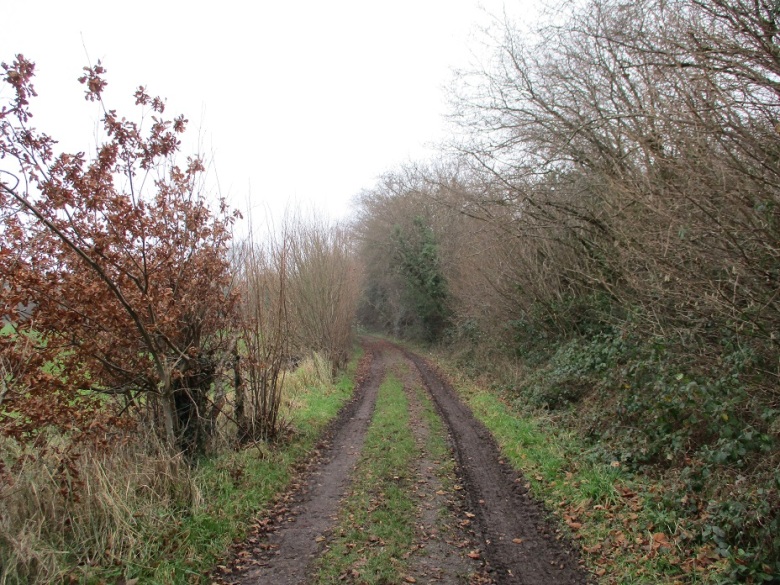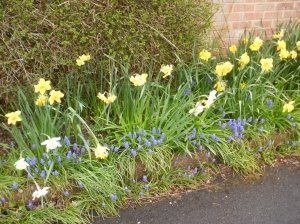Hello, Mrs Hg137 here.
After a few very wet days, everything was rather soggy, and we decided against a country-based geocaching walk: probably too muddy. Instead, we picked a semi-urban route, thinking that the paths underfoot would be reasonably firm and dry … and so we found ourselves walking through the longish grass at the edge of a fairly damp football field while a children’s team played. Everyone was watching the football, and not us, so we thought we would be fine to get on with our caching without being spotted.
The series we were following is called ‘Bees Knees’ in homage to the Bracknell Bees Ice Hockey team who used to play nearby. The Bees have now buzzed off to Slough to play and their stadium has been demolished.
Having read the cache descriptions, we knew we would need extra ‘equipment’ and had brought a variety of geocacher’s tools with us. As we approached the first cache, we realised that our selection of tools didn’t include anything suitable for this. We found a handy substitute nearby (phew!) and used it to retrieve and replace the cache. The makeshift tool was better than anything we would have brought with us.
Moving on … it was good to be walking along a firm pavement rather than a muddy track to our next cache. On arrival, we looked up and realised we were again a tool short. (I had decided against bringing a walking pole with me as it would have stood out in a town.) We cast around and found a piece of scrap metal which was perfect for the job. After a bit of wafting and prodding, the container dropped into our hands. Now to return the cache … with pauses while we waited for traffic to pass by … it took us numerous attempts before we carefully nudged the cache back into position with the piece of scrap metal. All good fun!
Our next two caches weren’t so high up, so easier to reach. However, that gave Mr Hg137 the chance to scrape his knuckles on something or other and he then bled redly and grumpily for a bit. Meanwhile, I removed, signed and replaced the cache without incident, even pausing midway to stick a plaster onto the injured hand. This bit of our route is very close to where the stadium used to be; while development is going on nearby, the stadium is currently empty land and is a bit sad.
We moved on to the next cache. So far, we’d not been especially well prepared, but had muddled through and found/replaced everything. This time round, we’d belatedly read the cache description and had realised we needed to arm ourselves with a tool (which, once again, we’d failed to bring). While walking to the cache, we found something moderately suitable, and brought it with us. It did the trick … now to replace it. Hmm. Mr Hg137 opted for trying to throw the cache back into position – which didn’t seem to be a terribly good idea – but, at the third or fourth attempt, the cache landed within inches of its starting point, and simply needed a gentle nudge or two from the makeshift tool to push it the last little bit. (If you had happened to be in this part of Bracknell on this day, and had seen two slightly damp and dishevelled people carrying assorted sticks and bits of metal … it was us!)
A longer walk between houses took us to some woodland, Farley Copse , once part of the grounds of Farley Moor House. We spotted a group of people working away in the woodland and rushed off to talk to some of them, busily planting up a new pond; they turned out to be from Binfield Environment Group and they were doing a great job. We walked on through the woods, stopped for a coffee break, chatted to some muggle dogs, admired a mature Wellingtonia (a survivor from the former estate), and found more caches; an interesting bit of woodland.




There was just one more cache to find from the series and we had read that it was a bit special and would need time. This time, we did have the correct selection of tools with us. FYI – some caches require ‘extra’ equipment – we’d come prepared with a penknife, torch, string, pen, paper, water bottle, magnet, etc, etc. Other caches need things like ropes, ladders, catapult, fishing poles, climbing equipment, canoes; we hadn’t brought those, thinking they might be conspicuous on a suburban street …
We set about opening the cache, deploying some of our tools. There were several stages, each supplying something vital for the next part, and each needing a different technique. After some little time, and feeling just a bit conspicuous, we opened the third section, to find a capacious log book and a big jar for trackables – we took one. This cache may well appear on our ‘caches of the year’ post later on this year.
In summary: Iffy weather, excellent caching! And the moral for this series was : read all the descriptions beforehand. We made our way through the caches with the tools we’d brought, plus bits and pieces found nearby, but we would have done better if we’d brought some of the other tools mentioned in the descriptions.
And here are just a few of the caches we found:




































































































